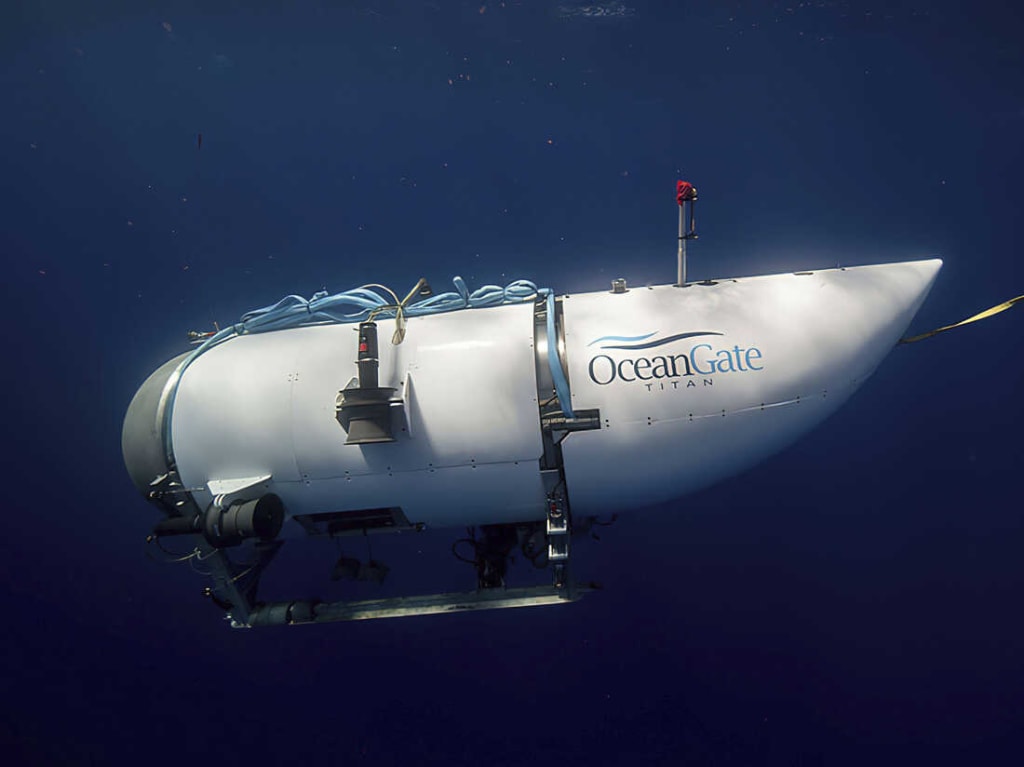Content warning
This story may contain sensitive material or discuss topics that some readers may find distressing. Reader discretion is advised. The views and opinions expressed in this story are those of the author and do not necessarily reflect the official policy or position of Vocal.
Titanic Submersible Disaster
An Engineer's Analysis

On June 18, 2023, the submersible named Titan, operated by Ocean Gate, went missing in international waters in the North Atlantic Ocean off the coast of Newfoundland, Canada. The submersible was on a tourist expedition to view the wreckage of the RMS Titanic, with five individuals on board, including Stockton Rush, the founder and CEO of Ocean Gate. Despite a massive rescue effort by the U.S. Coast Guard and Canada's Coast Guard, the submersible was not found until early on June 22nd when evidence of the wreckage started to emerge. It was concluded that the vessel imploded in the ocean depths, and there were no survivors.
Let's begin by discussing the company operating the Titan, Ocean Gate Incorporated. It is a privately held U.S. company based in Everett, Washington, that provides submersibles for the tourism industry and research and exploration purposes. The company was founded in 2009 by Stockton Rush and Guillermo Solen. Stockton Rush, originally aspiring to be an astronaut, became an engineer and worked at McDonald Douglas as a flight test engineer before shifting his focus to undersea exploration.
The tragic events occurred during a deep-sea tourism expedition to explore the wreckage of the Titanic, which sank in the Northern Atlantic in 1912. Deep-sea exploration presents significant challenges, primarily due to the immense pressure at great depths. Water is much denser than air, and as you descend every 10 meters, the pressure increases by one atmosphere. The wreckage of the Titanic sits about 12,500 feet below sea level, with its bow and stern more than 2,600 feet apart, surrounded by debris.
Deep-sea exploration presents numerous challenges, and there were red flags associated with Ocean Gate from the beginning. The design of the Titan had limitations, such as a hatch that could only be opened from the outside, relying on ground crews to open it. The submersible lacked GPS or other navigational instruments, as well as a locator beacon. Instead, it relied on data provided by the surface support vessel.
Ocean Gate's claim that most accidents in the marine and aviation industry are due to operator error rather than mechanical failure is questionable. Journalist David Progue, who rode on the Titan in 2022, noted that the surface support vessel lost track of the Titan for several hours, indicating a lack of proper tracking and communication systems.
The control of the submersible was done using a video game controller, which raised concerns about the level of engineering rigor and reliability. Furthermore, it was revealed that the carbon fiber hull of the Titan had not undergone non-destructive testing to check for any weaknesses that could compromise its strength.
There were also controversies surrounding Ocean Gate in relation to the incident. It was revealed that the company had cut corners and taken shortcuts in their operations. The submersible, Titan, had not undergone proper safety inspections and certifications. The lack of essential equipment, such as GPS, navigational instruments, and a locator beacon, further raised concerns about Ocean Gate's commitment to safety.
Additionally, the decision to rely solely on data provided by the surface support vessel for navigation was a critical oversight. This dependency on external information without redundant systems compromised the safety of the expedition. The surface support vessel's failure to track the Titan for several hours highlights the lack of robust tracking and communication systems, which could have contributed to the delay in locating the missing submersible.
As investigations continue, it is essential to address the systemic failures that led to this tragic incident. The deep-sea exploration industry must prioritize safety and adhere to stringent regulations to prevent such accidents in the future. The lessons learned from this disaster should serve as a wake-up call for all involved in submersible operations, emphasizing the need for comprehensive safety protocols, regular inspections, and the use of advanced technology to ensure the well-being of those venturing into the depths of the ocean.
It is my hope that the loss of the Titan and its crew will prompt a reevaluation of safety practices and instigate changes within the industry to prevent similar tragedies from occurring. Deep-sea exploration holds tremendous potential for scientific discoveries and the preservation of our maritime heritage, but it must be pursued with the utmost care and responsibility.
About the Creator
Keresa Harris
I Write, therefore I am.
These profound words encapsulate the essence of who I am.
Writing is my sanctuary—a place where I explore, create, and make sense of the myriad emotions and ideas.
Enjoyed the story? Support the Creator.
Subscribe for free to receive all their stories in your feed. You could also pledge your support or give them a one-off tip, letting them know you appreciate their work.





Comments
There are no comments for this story
Be the first to respond and start the conversation.